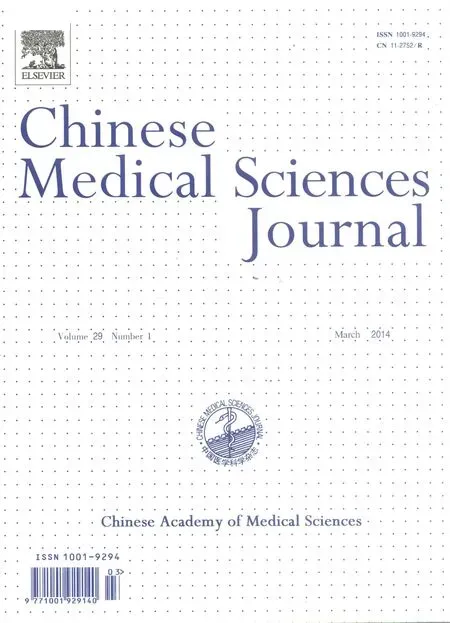Thromboelastography in Women with Pathological Pregnancies: a Preliminary Study
Wei Wang, Ai-ming Wang*, Xin-qiang Huang, Wen Jiang, and Xiao-ning Jia
1Department of Obstetrics and Gynecology, 2Department of Clinical Laboratory, Navy General Hospital of PLA, Beijing 100048, China
ABNORMALITIES during pregnancy are regarded as pathological pregnancy. Early detection of anomalies is urgent to take measures as soon as possible to prevent serious pregnancy complications. Procoagulant-anticoagulant imbalance is often the pathological basis of many pathological pregnancy conditions, leading to a hypercoagulable state. We compared the thromboelastographic parameters between pathological pregnancy and normal pregnancy patients, evaluated the value of thromboelastography in early detecting pathological pregnancy and predicting postpartum hemorrhage.
Altogether 190 women with pathological pregnancies (study group) and 75 women of normal pregnancies at the same period (control group) were recruited from July 2010 to September 2012 in Navy General Hospital of PLA. The study group included 45 cases of preeclampsia (20 were mild preeclampsia and 25 were severe preeclampsia), 50 cases of gestational diabetes mellitus (GDM), 70 cases of pregnancy hypercoagulable state, and 25 cases of deep venous thrombosis. The diagnosis of preeclampsia was in accordance with American College of Obstetrics and Gynecology guidelines and criteria established in comparable studies. The diagnosis of GDM was in accordance with the International Association of Diabetes in Pregnancy Study Group Recommendations. The screening and diagnosis of GDM was based on the result of 75 g 2-hour oral glucose tolerance test. The hypercoagulable state patients in this study showed a D-dimer level 3 times the upper limit of reference range (16-300 μg/L) but the conventional coagulation tests were normal. The women with deep venous thrombosis were diagnosed with ultrasound. The blood samples of the study group were taken before any intervention once diagnosed. Obstetric complications were excluded for the patients in control group. Medical and surgical complications were excluded in both groups. All the enrolled patients took no drugs affecting coagulation in 2 weeks. The parameters of thromboelastography in the patients included reaction time (R), clot formation time (K), clot formation rate (α angle), maximum amplitude (MA), and coagulation index (CI). Postpartum hemorrhage was observed.
The parameters of the control group were within the reference ranges. The K time was significantly shorter in the study group than in control group (P=0.027). The α angle (P=0.011), MA (P=0.045), and CI (P=0.036) were significantly higher in study group. No significant differences in the 5 variables were observed between the control and the preeclampsia groups. The thrombo- elastographic parameters in the GDM patients showed hypercoagulable state changes compared with the control group, but the differences were not significant. The K time was shorter, and α angle, MA, and CI higher in hypercoagulable state group than in the control group (all P<0.01). Thrombosis group had a shorter R time and a larger α angle compared with the control group (both P<0.05).
The incidence of postpartum hemorrhage was 8.4% (16/190) in the study group, 5.3% (4/75) in the control group. The 16 cases of postpartum hemorrhage in the study group were severe preeclampsia (4/45, 8.9%), pregnancy hypercoagulable state (9/70, 12.9%), and deep venous thrombosis (3/25, 12%). The level of D-dimer was over 1200 μg/L in 9 women with pregnancy hypercoagulable state. The MA of preeclampsia patients in postpartum hemorrhage group was significantly higher than that in non-hemorrhage group (P<0.05). In hypercoagulable state patients, K time was significantly shorter, and α angle, MA, and CI significantly higher in postpartum hemorrhage group compared with non-hemorrhage group (P<0.05). The R time was shorter and MA was higher in thrombosis patients having postpartum hemorrhage than in non- hemorrhage group (P<0.05).
In conclusion, thromboelastography could identify the changes of pathological pregnancy coagulation fast and accurately, helping to predict the risk of postpartum hemorrhage.
 Chinese Medical Sciences Journal2014年1期
Chinese Medical Sciences Journal2014年1期
- Chinese Medical Sciences Journal的其它文章
- Sorafenib in Liver Function Impaired Advanced Hepatocellular Carcinoma
- Isolated Pancreatic Tuberculosis in Non-immunocompromised Patient Treated by Whipple’s Procedure: a Case Report
- Reversible Posterior Leukoencephalopathy Syndrome in Children with Nephrotic Syndrome: a Case Report
- Laryngo-tracheobronchial Amyloidosis: a Case Report and Review of Literature
- Comparison of the Outcomes of Monopolar and Bipolar Radiofrequency Ablation in Surgical Treatment of Atrial Fibrillation
- Bloodstream Infection with Carbapenem-resistant Klebsiella Pneumoniae and Multidrug-resistant Acinetobacter Baumannii: a Case Report
